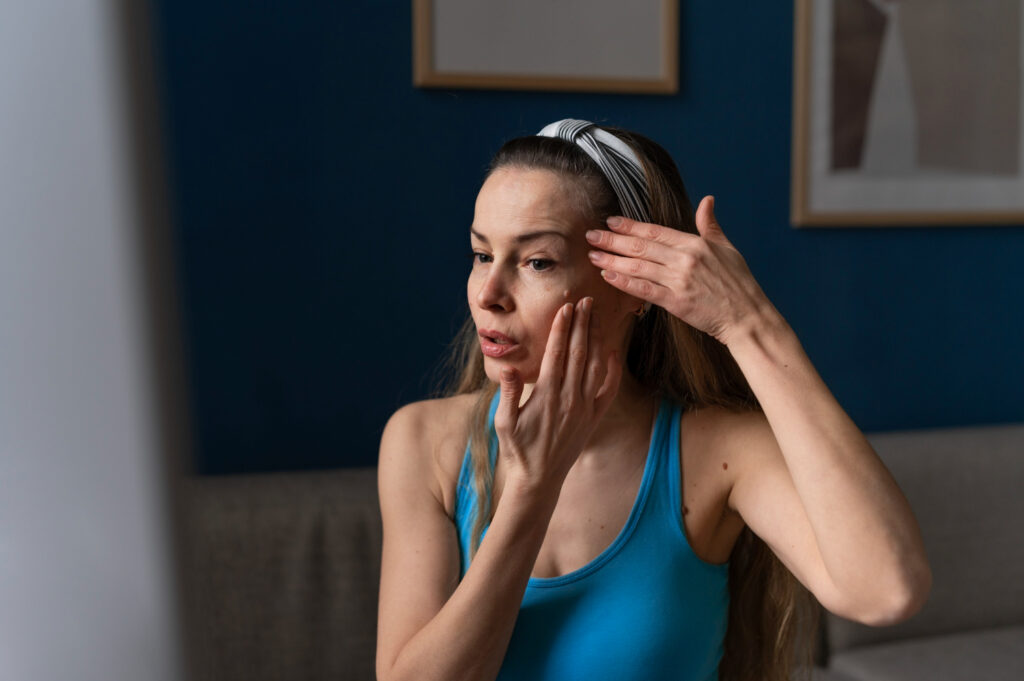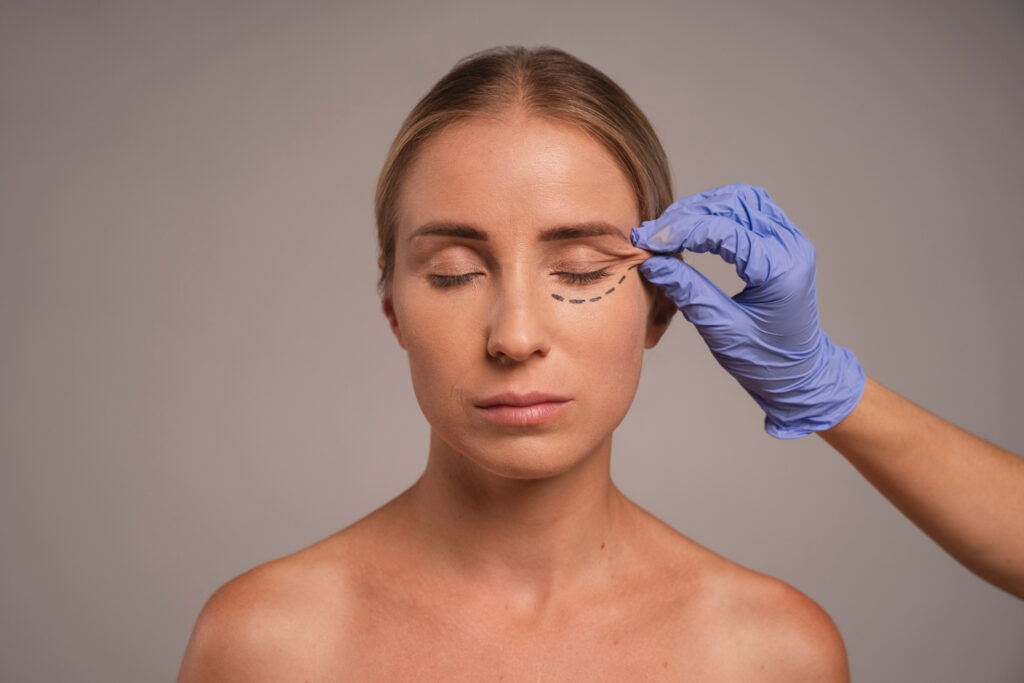You’ve been there. That moment when you drag yourself to the bathroom mirror after a night of tossing and turning, only to be greeted by a pair of dull, shadowy half-moons beneath your eyes. Even before the yawns and brain fog kick in, those telling under-eye circles announce to the world: “I didn’t sleep well last night!”
But why is the delicate skin beneath our eyes always the first to betray our sleep secrets? Let’s dive into the fascinating science behind this common beauty concern that affects so many of us.
The Telltale Window to Your Sleep Quality
The skin around your eyes is approximately 40% thinner than the skin covering the rest of your face. This delicate tissue contains fewer oil glands and collagen fibers, making it especially vulnerable to changes in your body—including those caused by insufficient sleep.
Think of your under-eye area as the canary in the coal mine of your wellness routine. When sleep goes off track, this area sounds the alarm before anywhere else.
What Actually Happens Under Your Eyes During Sleep Deprivation?
When you don’t get enough quality sleep, several biological processes converge beneath your eyes:
1. Blood Vessel Expansion
During sleep deprivation, your body releases stress hormones like cortisol, which can cause the blood vessels beneath your thin under-eye skin to dilate. With more blood flowing through more visible vessels, the result is darker circles that appear purple or bluish.
Jessica, a 34-year-old marketing executive from Boston, describes it perfectly: “After my deadline weeks, I can literally watch the shadows form under my eyes with each missed hour of sleep. By Friday, it looks like I’ve been in a minor fistfight.”
2. Fluid Retention Creates Puffiness
Your body follows natural rhythms with fluid balance. During healthy sleep cycles, you process and eliminate excess fluids. Without proper rest, fluid can accumulate in areas where skin is thin—particularly under your eyes.
This retention creates puffiness that casts shadows, contributing to that dull, tired appearance. It’s essentially your lymphatic system moving in slow motion without the recharge it needs.
3. Decreased Circulation Equals Less Glow
Beauty sleep isn’t just a cute phrase—it’s biological reality. During deep, restorative sleep phases, your body increases blood flow to the skin, delivering nutrients and oxygen that create that refreshed morning glow.
Skip those deep sleep cycles, and your skin doesn’t receive its nightly circulation boost. The result? Dullness that’s particularly noticeable in the translucent under-eye region.
4. Micro-Inflammation Response
Sleep deprivation triggers subtle inflammatory responses throughout your body. This micro-inflammation can cause slight swelling and redness that particularly affects delicate under-eye tissue.
Beyond Beauty: The Bigger Story Your Eyes Tell
While we often focus on the cosmetic impact of under-eye dullness, these changes represent something more significant happening in your body:
- Stress hormone fluctuations that impact everything from mood to metabolism
- Immune system adjustments that can affect your overall resilience
- Cognitive processing changes that influence focus and memory
Dr. Sarah Chen, a sleep researcher (not affiliated with this website), notes: “The eyes reflect our overall wellness state with remarkable accuracy. When patients come in concerned about persistent under-eye issues, we often discover sleep quality problems that affect many aspects of their health.”
Your Personal Under-Eye Timeline
Have you noticed how quickly your under-eye area responds to sleep changes? This typical timeline may sound familiar:
- One night of poor sleep: Mild puffiness, slight darkness
- Two consecutive nights: More noticeable circles, beginning of dullness
- Three+ nights: Pronounced shadows, visible puffiness, loss of skin luminosity
And interestingly, different sleep issues create different under-eye effects:
- Difficulty falling asleep often creates redness and puffiness
- Interrupted sleep typically causes darker circles
- Early waking frequently results in dullness and fine lines
Supporting Your Under-Eye Region (And Your Sleep)
While we can’t change the naturally thin structure of our under-eye skin, we can support both this delicate area and our sleep quality:
Daily Habits That Help
- Stay hydrated throughout the day, but taper liquid consumption in the evening
- Apply cooling compresses for 5-10 minutes in the morning to reduce puffiness
- Elevate your head slightly while sleeping to prevent fluid accumulation
- Be gentle when applying or removing products around your eyes
- Protect this delicate skin with SPF during the day
Creating Better Sleep Conditions
- Establish a consistent sleep schedule that allows for 7-9 hours of rest
- Create a wind-down routine that signals your body it’s time for sleep
- Reduce blue light exposure from screens in the hours before bedtime
- Consider room-darkening curtains to eliminate sleep-disrupting light
- Find your ideal sleep temperature (typically between 60-67°F for most people)
Nutritional Support
Certain nutrients particularly support the delicate skin around your eyes:
- Vitamin K helps strengthen capillary walls (found in leafy greens and broccoli)
- Vitamin C supports collagen production (abundant in citrus fruits and bell peppers)
- Omega-3 fatty acids help maintain skin barrier function (found in fatty fish, walnuts, and flaxseeds)
- Antioxidants fight free radical damage (present in colorful fruits and vegetables)
When Under-Eye Changes Persist
While occasional under-eye dullness following a poor night’s sleep is normal, persistent changes despite adequate rest might warrant deeper exploration of your overall wellness routine. Factors like allergies, hydration habits, and natural aging processes can all influence the appearance of this delicate area.
Michelle, a 42-year-old teacher from Chicago, shares: “I thought my permanent under-eye circles were just lack of sleep from grading papers late into the night. When they didn’t improve during summer break, I realized I needed to look at other factors in my routine.”
The Connection Between Stress and Your Under-Eyes
It’s not just lack of sleep that affects your under-eye appearance—it’s also the quality of the sleep you get. Stress-disrupted sleep, even if you’re technically in bed for enough hours, can show up clearly beneath your eyes.
When stress hormones remain elevated, they can:
- Interfere with deep sleep cycles
- Cause muscle tension that restricts healthy circulation
- Trigger inflammatory responses that affect skin appearance
This explains why sometimes even after what should have been “enough” sleep, your eyes still tell a different story.
Embracing Your Sleep-Beauty Connection
Understanding the relationship between sleep and your under-eye appearance offers a window into your body’s needs. Rather than just covering up those shadows with concealer, consider them valuable feedback about your sleep habits.
By addressing the root causes of sleep disruption and supporting your body’s natural restoration processes, you’ll not only wake up to brighter eyes but also to improved overall wellbeing.
After all, the skin beneath your eyes isn’t just telling a beauty story—it’s telling a sleep story. And better sleep quality benefits everything from your cognitive function to your emotional resilience, with the added bonus of more radiant under-eyes.
Your Under-Eye Reflection
The next time you notice dullness beneath your eyes after a restless night, remember you’re seeing the intersection of physiology, sleep quality, and your body’s natural processes. By supporting better sleep habits, you’re investing not just in brighter under-eyes, but in your complete wellbeing.

Disclaimer: This article is for informational purposes only and does not constitute medical advice. The information provided is not intended to diagnose, treat, cure or prevent any condition or disease. Always consult with a qualified healthcare professional regarding any health concerns or before making changes to your wellness routine.

